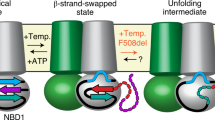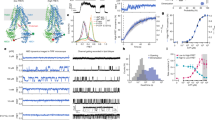Abstract
Mutations in the cystic fibrosis transmembrane conductance regulator (CFTR), an integral membrane protein, cause cystic fibrosis (CF). The most common CF-causing mutant, deletion of Phe508, fails to properly fold. To elucidate the role Phe508 plays in the folding of CFTR, missense mutations at this position were generated. Only one missense mutation had a pronounced effect on the stability and folding of the isolated domain in vitro. In contrast, many substitutions, including those of charged and bulky residues, disrupted folding of full-length CFTR in cells. Structures of two mutant nucleotide-binding domains (NBDs) reveal only local alterations of the surface near position 508. These results suggest that the peptide backbone plays a role in the proper folding of the domain, whereas the side chain plays a role in defining a surface of NBD1 that potentially interacts with other domains during the maturation of intact CFTR.
This is a preview of subscription content, access via your institution
Access options
Subscribe to this journal
Receive 12 print issues and online access
$189.00 per year
only $15.75 per issue
Buy this article
- Purchase on Springer Link
- Instant access to full article PDF
Prices may be subject to local taxes which are calculated during checkout




Similar content being viewed by others
References
Sheppard, D.N. & Welsh, M.J. Structure and function of the CFTR chloride channel. Physiol. Rev. 79, S23–S45 (1999).
Riordan, J.R. et al. Identification of the cystic fibrosis gene: cloning and characterization of complementary DNA. Science 245, 1066–1073 (1989).
Tsui, L.C. The spectrum of cystic fibrosis mutations. Trends Genet. 8, 392–398 (1992).
Tsui, L.C. The cystic fibrosis transmembrane conductance regulator gene. Am. J. Respir. Crit. Care Med. 151, S47–S53 (1995).
Cheng, S.H. et al. Defective intracellular transport and processing of CFTR is the molecular basis of most cystic fibrosis. Cell 63, 827–834 (1990).
Lukacs, G.L. et al. Conformational maturation of CFTR but not its mutant counterpart (ΔF508) occurs in the endoplasmic reticulum and requires ATP. EMBO J. 13, 6076–6086 (1994).
Denning, G.M., Ostedgaard, L.S. & Welsh, M.J. Abnormal localization of cystic fibrosis transmembrane conductance regulator in primary cultures of cystic fibrosis airway epithelia. J. Cell Biol. 118, 551–559 (1992).
Sharma, M., Benharouga, M., Hu, W. & Lukacs, G.L. Conformational and temperature-sensitive stability defects of the ΔF508 cystic fibrosis transmembrane conductance regulator in post-endoplasmic reticulum compartments. J. Biol. Chem. 276, 8942–8950 (2001).
Ward, C.L., Omura, S. & Kopito, R.R. Degradation of CFTR by the ubiquitin-proteasome pathway. Cell 83, 121–127 (1995).
Jensen, T.J. et al. Multiple proteolytic systems, including the proteasome, contribute to CFTR processing. Cell 83, 129–135 (1995).
Kartner, N., Augustinas, O., Jensen, T.J., Naismith, A.L. & Riordan, J.R. Mislocalization of ΔF508 CFTR in cystic fibrosis sweat gland. Nat. Genet. 1, 321–327 (1992).
Zhang, X.M. et al. Organic solutes rescue the functional defect in F508 CFTR. J. Biol. Chem. 278, 51232–51242 (2003).
Denning, G.M. et al. Processing of mutant cystic fibrosis transmembrane conductance regulator is temperature-sensitive. Nature 358, 761–764 (1992).
Sato, S., Ward, C.L., Krouse, M.E., Wine, J.J. & Kopito, R.R. Glycerol reverses the misfolding phenotype of the most common cystic fibrosis mutation. J. Biol. Chem. 271, 635–638 (1996).
Yang, H. et al. Nanomolar affinity small molecule correctors of defective ΔF508-CFTR chloride channel gating. J. Biol. Chem. 278, 35079–35085 (2003).
Brown, C.R., Hong-Brown, L.Q., Biwersi, J., Verkman, A.S. & Welch, W.J. Chemical chaperones correct the mutant phenotype of the ΔF508 cystic fibrosis transmembrane conductance regulator protein. Cell Stress Chaperones 1, 117–125 (1996).
Dormer, R.L. et al. Correction of delF508-CFTR activity with benzo(c)quinolizinium compounds through facilitation of its processing in cystic fibrosis airway cells. J. Cell Sci. 114, 4073–4081 (2001).
Howard, M. et al. Mammalian osmolytes and S-nitrosoglutathione promote ΔF508 cystic fibrosis transmembrane conductance regulator (CFTR) protein maturation and function. J. Biol. Chem. 278, 35159–35167 (2003).
Thomas, P.J., Ko, Y.H. & Pedersen, P.L. Altered protein folding may be the molecular basis of most cases of cystic fibrosis. FEBS Lett. 312, 7–9 (1992).
Zeitlin, P.L. Therapies directed at the basic defect in cystic fibrosis. Clin. Chest Med. 19, 515–525 (1998).
Locher, K.P., Lee, A.T. & Rees, D.C. The E. coli BtuCD structure: a framework for ABC transporter architecture and mechanism. Science 296, 1091–1098 (2002).
Chang, G. Structure of MsbA from Vibrio cholera: a multidrug resistance ABC transporter homolog in a closed conformation. J. Mol. Biol. 330, 419–430 (2003).
Qu, B.H., Strickland, E.H. & Thomas, P.J. Localization and suppression of a kinetic defect in cystic fibrosis transmembrane conductance regulator folding. J. Biol. Chem. 272, 15739–15744 (1997).
Qu, B.H. & Thomas, P.J. Alteration of the cystic fibrosis transmembrane conductance regulator folding pathway. J. Biol. Chem. 271, 7261–7264 (1996).
Myers, J.K., Pace, C.N. & Scholtz, J.M. Denaturant m values and heat capacity changes: relation to changes in accessible surface areas of protein unfolding. Protein Sci. 4, 2138–2148 (1995).
Lewis, H.A. et al. Structure of nucleotide-binding domain 1 of the cystic fibrosis transmembrane conductance regulator. EMBO J. 23, 282–293 (2004).
Karpowich, N. et al. Crystal structures of the MJ1267 ATP binding cassette reveal an induced-fit effect at the ATPase active site of an ABC transporter. Structure 9, 571–586 (2001).
Chen, W., Helenius, J., Braakman, I. & Helenius, A. Cotranslational folding and calnexin binding during glycoprotein synthesis. Proc. Natl. Acad. Sci. USA 92, 6229–6233 (1995).
Jansens, A., van Duijn, E. & Braakman, I. Coordinated nonvectorial folding in a newly synthesized multidomain protein. Science 298, 2401–2403 (2002).
Du, K., Sharma, L. & Lukacs, G.L. The ΔF508 cystic fibrosis mutation impairs domain-domain interactions and arrests post-translational folding of CFTR. Nat. Struct. Mol. Biol. 12, 17–25 (2005).
Yuan, Y.R. et al. The crystal structure of the MJ0796 ATP-binding cassette. Implications for the structural consequences of ATP hydrolysis in the active site of an ABC transporter. J. Biol. Chem. 276, 32313–32321 (2001).
Gaudet, R. & Wiley, D.C. Structure of the ABC ATPase domain of human TAP1, the transporter associated with antigen processing. EMBO J. 20, 4964–4972 (2001).
Ames, G.F. et al. Purification and characterization of the membrane-bound complex of an ABC transporter, the histidine permease. J. Bioenerg. Biomembr. 33, 79–92 (2001).
Liu, P.Q. & Ames, G.F. In vitro disassembly and reassembly of an ABC transporter, the histidine permease. Proc. Natl. Acad. Sci. USA 95, 3495–3500 (1998).
Mourez, M., Hofnung, M. & Dassa, E. Subunit interactions in ABC transporters: a conserved sequence in hydrophobic membrane proteins of periplasmic permeases defines an important site of interaction with the ATPase subunits. EMBO J. 16, 3066–3077 (1997).
Wilken, S., Schmees, G. & Schneider, E. A putative helical domain in the MalK subunit of the ATP-binding-cassette transport system for maltose of Salmonella typhimurium (MalFGK2) is crucial for interaction with MalF and MalG. A study using the LacK protein of Agrobacterium radiobacter as a tool. Mol. Microbiol. 22, 655–666 (1996).
Tector, M. & Hartl, F.U. An unstable transmembrane segment in the cystic fibrosis transmembrane conductance regulator. EMBO J. 18, 6290–6298 (1999).
Chen, E.Y., Bartlett, M.C., Loo, T.W. & Clarke, D.M. The ΔF508 mutation disrupts packing of the transmembrane segments of the cystic fibrosis transmembrane conductance regulator. J. Biol. Chem. 279, 39620–39627 (2004).
Loo, T.W., Bartlett, M.C. & Clarke, D.M. Introduction of the most common cystic fibrosis mutation (ΔF508) into human P-glycoprotein disrupts packing of the transmembrane segments. J. Biol. Chem. 277, 27585–27588 (2002).
Meacham, G.C. et al. The Hdj-2/Hsc70 chaperone pair facilitates early steps in CFTR biogenesis. EMBO J. 18, 1492–1505 (1999).
Xiong, X., Bragin, A., Widdicombe, J.H., Cohn, J. & Skach, W.R. Structural cues involved in endoplasmic reticulum degradation of G85E and G91R mutant cystic fibrosis transmembrane conductance regulator. J. Clin. Invest 100, 1079–1088 (1997).
Sato, S., Ward, C.L. & Kopito, R.R. Cotranslational ubiquitination of cystic fibrosis transmembrane conductance regulator in vitro. J. Biol. Chem. 273, 7189–7192 (1998).
Miller, S.R., Sekijima, Y. & Kelly, J.W. Native state stabilization by NSAIDs inhibits transthyretin amyloidogenesis from the most common familial disease variants. Lab Invest. 84, 545–552 (2004).
Fan, J.Q., Ishii, S., Asano, N. & Suzuki, Y. Accelerated transport and maturation of lysosomal α-galactosidase A in Fabry lymphoblasts by an enzyme inhibitor. Nat. Med. 5, 112–115 (1999).
Pace, C.N. & Shaw, K.L. Linear extrapolation method of analyzing solvent denaturation curves. Proteins, Suppl 4, 1–7 (2000).
Mossessova, E. & Lima, C.D. Ulp1-SUMO crystal structure and genetic analysis reveal conserved interactions and a regulatory element essential for cell growth in yeast. Mol. Cell 5, 865–876 (2000).
Otwinowski, Z. & Minor, W. Processing of X-ray diffraction data collected in oscillation mode. Methods Enzymol. 276, 307–326 (1997).
Brunger, A.T. et al. Crystallography & NMR system: a new software suite for macromolecular structure determination. Acta Crystallogr. D 54, 905–921 (1998).
McRee, D.E. A visual protein crystallographic software system for X11/Xview. J. Mol. Graph. 10, 44–46 (1992).
Nicholls, A., Sharp, K.A. & Honig, B. Protein folding and association: insights from the interfacial and thermodynamic properties of hydrocarbons. Proteins 11, 281–296 (1991).
Lewis, H.A. et al. Impact of the Δ508 mutation in NBD1 of human CFTR on domain folding and structure. J. Biol. Chem. Epub ahead of print, 3 November 2004 (doi:10.1074/jbc.M410968200).
Acknowledgements
We thank H. Lewis and M. Kearins for helpful advice regarding production of the two NBD1 crystal forms and members of the Thomas lab and the Structural Biology Lab for helpful suggestions and constructive criticism. This work was supported by grants from the US National Institutes of Health (NIH) (DK49835), the Cystic Fibrosis Foundation (THOMAS01GO) and Welch Foundation (I-1284) to P.J.T. and by a position on the NIH Training Grant, Mechanisms of Drug Action and Disposition (GM07062), awarded to P.H.T.
Author information
Authors and Affiliations
Corresponding author
Ethics declarations
Competing interests
The authors declare no competing financial interests.
Supplementary information
Supplementary Fig. 1
Mutant NBD1 structures and conformations. (PDF 886 kb)
Rights and permissions
About this article
Cite this article
Thibodeau, P., Brautigam, C., Machius, M. et al. Side chain and backbone contributions of Phe508 to CFTR folding. Nat Struct Mol Biol 12, 10–16 (2005). https://doi.org/10.1038/nsmb881
Received:
Accepted:
Published:
Issue Date:
DOI: https://doi.org/10.1038/nsmb881
This article is cited by
-
ABC-transporter CFTR folds with high fidelity through a modular, stepwise pathway
Cellular and Molecular Life Sciences (2023)
-
Targeting DNAJB9, a novel ER luminal co-chaperone, to rescue ΔF508-CFTR
Scientific Reports (2019)
-
Molecular modelling and molecular dynamics of CFTR
Cellular and Molecular Life Sciences (2017)
-
Codon bias and the folding dynamics of the cystic fibrosis transmembrane conductance regulator
Cellular & Molecular Biology Letters (2016)
-
Cystic fibrosis two-step
Science-Business eXchange (2012)



